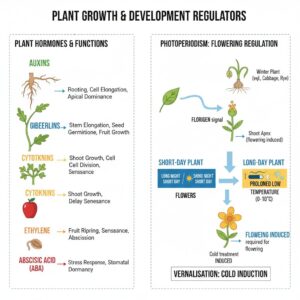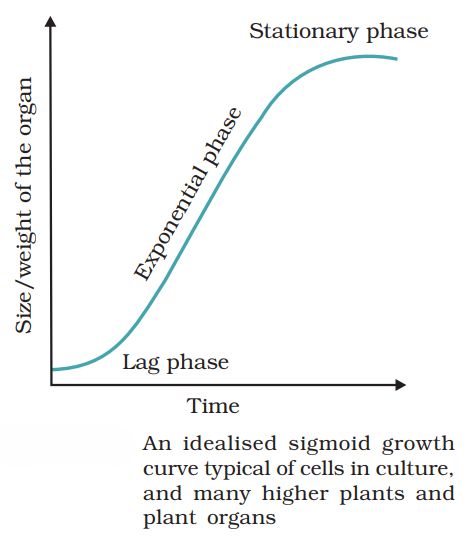1st PUC Biology Question and Answer: Plant Growth And Development
Looking for 1st PUC Biology textbook answers? You can download Chapter 15: Plant Growth And Development Questions and Answers PDF, Notes, and Summary here. 1st PUC Biology solutions follow the Karnataka State Board Syllabus, making it easier for students to revise and score higher in exams.
Karnataka 1st PUC Biology Textbook Answers—Reflections Chapter 15
Plant Growth And Development Questions and Answers, Notes, and Summary
1st PUC Biology Chapter 15
Plant Growth And Development

Scroll Down to Download Plant Growth And Development PDF Notes
Question and Answer:
Question 1.
Define growth, differentiation, development, dedifferentiation, redifferentiation, determinate growth, meristem and growth rate.
Answer:
- Growth:
Growth is a permanent and irreversible increase in the size of a living structure, accompanied by an increase in dry weight and the amount of protoplasm. - Differentiation:
The cells derived from the root apical meristem, shoot apical meristem, and cambium differentiate and mature to perform specific functions. This process leading to maturation is called differentiation. - Development:
Development includes all the changes that occur in an organism during its life cycle—from seed germination to growth, maturation, and senescence. It is a qualitative change referring to the nature of growth and form of the organism. - Dedifferentiation:
Sometimes, living differentiated cells lose their capacity for division. Under certain conditions, these cells may regain the ability to divide again. This phenomenon is called dedifferentiation. - Redifferentiation:
The cells formed from dedifferentiated cells that lose their ability to divide but mature again to perform specific functions undergo redifferentiation. This process is known as redifferentiation. - Determinate Growth:
When growth occurs only for a certain period and then stops after attaining maturity, it is called determinate growth. - Meristems:
Meristems are groups of undifferentiated plant cells that have the ability to divide continuously and form new cells. - Growth Rate:
The growth rate is the measure of the increase in growth (such as size or mass) per unit time.
Question 2.
Why is not any one parameter good enough to demonstrate growth throughout the life of a flowering plant?
Answer:
Growth, at the cellular level, is a consequence of an increase in the amount of protoplasm, which is difficult to measure directly. As a result, growth is manifested in different forms — such as an increase in weight, volume, length, or cell number, or sometimes a combination of these.
Therefore, no single parameter can accurately represent or demonstrate growth throughout the life of a flowering plant.
Question 3.
Describe briefly:
(a) Arithmetic growth
(b) Geometric growth
(c) Sigmoid growth curve
(d) Absolute and relative growth rates
Answer:
(a) Arithmetic Growth:
In arithmetic growth, one of the daughter cells continues to divide, while the other differentiates and matures.
The rate of growth remains constant and increases linearly with time.
Example: Elongation of roots and shoots at a constant rate
(b) Geometric Growth:
Geometric growth is characterized by slow growth in the initial stages and rapid growth during the later stages.
In this type of growth, the daughter cells produced by mitosis retain the ability to divide repeatedly. However, the rate of growth slows down later due to limited nutrient supply.
(c) Sigmoid Growth Curve:
The growth of living organisms in their natural environment is represented by an S-shaped (sigmoid) curve.
This curve shows three distinct phases:
- Lag Phase: Initial slow growth due to adjustment.
- Log or Exponential Phase: Rapid and maximum growth.
- Stationary Phase: Growth slows and becomes constant due to exhaustion of nutrients or space.

(d) Absolute and Relative Growth Rates:
- Absolute Growth Rate (AGR): Refers to the measurement and comparison of total growth per unit time.
- Relative Growth Rate (RGR): Refers to the growth of a particular system per unit time, expressed on a common basis (such as initial size or weight).
Question 4.
List five main groups of natural plant growth regulators. Write a note on discovery, physiological functions and agricultural/horticultural applications of any one of them.
Answer:
Five Main Groups of Natural Plant Growth Regulators
The five main groups of natural plant growth regulators (also called phytohormones or plant hormones) are:
- Auxins
- Gibberellins (GAs)
- Cytokinins (CKs)
- Abscisic Acid (ABA)
- Ethylene (This is the one missing from your introductory list, as it is a well-known inhibitor/ripening hormone).
Note on Auxins
The discovery of auxins began with the observations of Charles Darwin and his son, Francis Darwin, on phototropism (the bending of a plant toward a light source) in the coleoptiles (protective sheath) of canary grass. They concluded that a “transmittable influence” originating from the coleoptile tip caused the bending.
Later, F.W. Went isolated the active substance by placing excised oat coleoptile tips on agar blocks. The substance diffused into the agar, which, when placed on a decapitated coleoptile stump, caused a curvature. This substance was identified as auxin. The most common natural auxin is Indole-3-acetic acid (IAA).
Physiological Functions 🌱
Auxins are primarily considered plant growth promoters and are involved in:
- Cell enlargement and stem elongation.
- Initiation of rooting in stem cuttings.
- Controlling apical dominance, where the growth of the terminal (apical) bud suppresses the growth of lateral (axillary) buds.
- Inducing parthenocarpy (fruit development without fertilization, resulting in seedless fruit) in some plants.
- Promoting flowering (e.g., in pineapples).
- Controlling xylem differentiation and aiding cell division.
Agricultural/Horticultural Applications 🧑🌾
Auxins, including natural ones like IAA and synthetic ones like NAA (naphthalene acetic acid) and 2,4-D (2,4-dichlorophenoxyacetic acid), are extensively used:
- Plant Propagation: They are widely applied to the cut ends of stems to initiate rooting in stem cuttings.
- Apical Dominance Management: Removing the shoot tips (decapitation) is used in practices like tea plantations and hedge making to promote the growth of lateral buds, leading to a bushier plant.
- Weed Control: The synthetic auxin 2,4-D is a powerful herbicide used to selectively kill dicotyledonous weeds without harming mature monocotyledonous crops like grass, making it ideal for maintaining lawns and grain fields.
- Seedless Fruits: Used to commercially induce parthenocarpy in fruits such as tomatoes.
Question 5.
What do you understand by photoperiodism and vernalisation? Describe their significance.
Answer:
- Photoperiodism:Flowering in certain plants depends not only on a combination of light and dark exposures but also on their relative durations. This response of plants to periods of day/night is termed photoperiodism. Some hormonal substances (e.g. florigen) migrate from leaves to shoot apices for inducing flowering only when the plants are exposed to the necessary inductive photoperiod.
- Vernalization:It is the process of enabling low temperature to some temperate plants artificially so as to reduce the duration of vegetative phase and initiate the onset of reproductive phase or flowering verialisation has been successfully used in many winter annuals biennial plants, e.g. winter wheat winter barley, winter lye, winter rat, cabbage, pea, but, etc.
Question 6.
Why is abscisic acid also known as stress hormone?
Answer:Abscisic acid (ABA) is called the stress hormone be
cause it helps plants respond to various environmental stresses, such as drought, high salinity, cold, and water deficiency. Under stress conditions, ABA accumulates in plant tissues and triggers several protective responses.
For example, it induces stomatal closure to reduce water loss, promotes seed dormancy to prevent germination under unfavorable conditions, and activates stress-responsive genes that help the plant survive adverse environments. Thus, ABA plays a critical role in enhancing plant tolerance to stress, which is why it is referred to as the stress hormone.
Question 7.
‘Both growth and differentiation in higher plants are open’. Comment.
Answer:
In higher plants, new cells are always being added to the plant body by the activity of the meristem. This ability of the plants is due to the presence of meristems at certain locations in their body. Meristems have the capacity to divide and self-perpetuate. The cells formed by these meristems later differentiate into different types of tissues and organs.
Question 8.
Both a short day plant and a long day plant can produce can flower simultaneously in a given place’. Explain.
Answer:
A short-day plant (SDP) flowers when the day length is shorter than a critical duration, while a long-day plant (LDP) flowers when the day length is longer than a critical duration. However, both types of plants can flower simultaneously if the photoperiodic conditions of that place match the critical day lengths for both plants.
For example, if the day length is intermediate such that it is short enough for the SDP and long enough for the LDP, both plants may complete their flowering at the same time. Additionally, manipulation of light exposure in controlled conditions can induce simultaneous flowering. This shows that flowering in plants depends on relative day length and the plant’s critical photoperiod requirement, rather than absolute day length.
Question 9.
Which one of the plant growth regulators would you use if you are asked to:
(a) induce rooting in a twig
(b) quickly ripen a fruit
(c) delay leaf senescence
(d) induce growth in axillary buds
(e) ‘bolt’ a rosette plant
(f) induce immediate stomatal closure in leaves.
Answer:
(a) Induce rooting in a twig → Auxins (e.g., IAA, IBA, NAA)
(b) Quickly ripen a fruit → Ethylene
(c) Delay leaf senescence → Cytokinins
(d) Induce growth in axillary buds → Cytokinins
(e) ‘Bolt’ a rosette plant → Gibberellins
(f) Induce immediate stomatal closure in leaves → Abscisic acid (ABA)
Question 10.
Would a defoliated plant respond to photoperiodic cycle? Why?
Answer:
No, a defoliated plant cannot respond to photoperiod because leaves are required to perceive day length and produce florigen for flowering.
Question 11.
What would be expected to happen if:
(a) GA is applied to rice seedlings
(b) dividing cells stop differentiating
(c) a rotten fruit gets mixed with unripe fruits
(d) you forget to add cytokinin to the culture medium.
Answer:
(a) GA is applied to rice seedlings → Stem elongation will increase, as gibberellins promote cell elongation and division, potentially producing taller seedlings.
(b) Dividing cells stop differentiating → New tissues and organs will not form, leading to abnormal plant development and a failure to produce functional leaves, stems, or flowers.
(c) A rotten fruit gets mixed with unripe fruits → The unripe fruits will ripen faster due to the release of ethylene from the rotten fruit, which acts as a ripening hormone.
(d) You forget to add cytokinin to the culture medium → Callus may proliferate but will not differentiate into shoots, since cytokinins are essential for shoot induction and growth of axillary buds.
Additional Questions and Answers
Question 1:
What is the difference between growth promoters and growth inhibitors in plants?
Answer:
- Growth promoters: Substances that stimulate plant growth, e.g., auxins, gibberellins, cytokinins. They promote cell division, elongation, and differentiation.
- Growth inhibitors: Substances that slow down or inhibit growth, e.g., abscisic acid (ABA). They help plants respond to stress and regulate dormancy, abscission, and stomatal closure.
Question 2:
Name the naturally occurring auxins and their synthetic forms.
Answer:
- Natural auxins: IAA (Indole-3-acetic acid), IBA (Indole-3-butyric acid)
- Synthetic auxins: NAA (Naphthalene acetic acid), 2,4-D (2,4-Dichlorophenoxyacetic acid)
Question 3:
What is apical dominance and which hormone controls it?
Answer:
- Apical dominance: The phenomenon where the apical bud suppresses the growth of lateral buds.
- Hormone involved: Auxins; removing the apical bud (decapitation) promotes lateral bud growth.
Question 4:
Explain the role of ethylene in plants.
Answer:
- Ethylene is a gaseous plant hormone.
- Functions include: fruit ripening, leaf and flower abscission, and stress responses.
- It is widely used in agriculture to ripen fruits artificially.
Question 5:
How does gibberellin help in agriculture?
Answer:
- Promotes stem elongation, e.g., in sugarcane to increase yield.
- Induces bolting in rosette plants (e.g., cabbage, lettuce).
- Promotes seed germination, flowering, and fruit development.
Question 6:
What is florigen?
Answer:
- Florigen is a flowering hormone produced in leaves under the appropriate photoperiod.
- It is transported to the shoot apical meristem to initiate flowering.
Question 7:
Define vernalisation and give two examples of crops where it is applied.
Answer:
- Vernalisation: Induction of flowering by exposing plants to low temperatures.
- Examples: Winter wheat, winter barley, cabbage, pea.
Question 8:
How do cytokinins affect plant growth?
Answer:
- Promote cell division, lateral bud growth, and adventitious shoot formation.
- Delay leaf senescence and enhance nutrient mobilization.
Question 9:
Why is ABA called the stress hormone?
Answer:
- ABA accumulates under stress conditions (drought, salinity, cold).
- It induces stomatal closure, seed dormancy, and activates stress-response genes, helping plants survive adverse conditions.
Question 10:
Give one practical application of auxins, gibberellins, cytokinins, ethylene, and ABA each.
Answer:
- Auxins: Rooting in stem cuttings
- Gibberellins: Bolting of rosette plants
- Cytokinins: Shoot induction in tissue culture
- Ethylene: Artificial fruit ripening
- ABA: Inducing stomatal closure during drought
